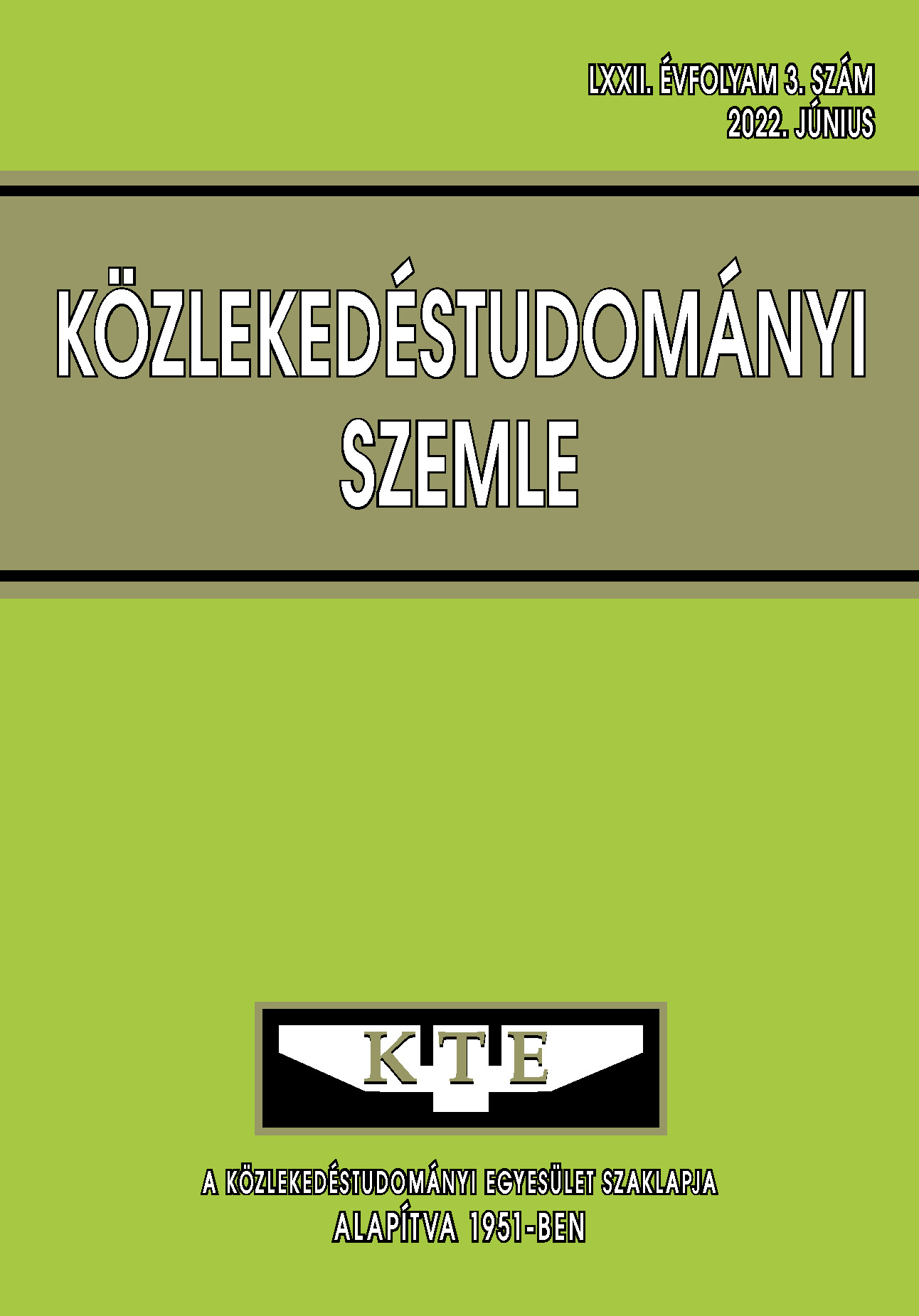Traffic safety education in kindergartens
Abstract
A gyermek közös kincsünk, a jövőnk záloga. A gyermekek nevelésén, a beléjük fektetett energiákon múlik a jövő társadalma. A középtávon végrehajtandó főbb közlekedésbiztonsági feladatokat tartalmazó Közúti Közlekedésbiztonsági Akcióprogramok – illeszkedve az európai közlekedésbiztonsági programok célkitűzéseihez – is az egyik legfontosabb területként kezelik a gyermekek közlekedésre felkészítését.
References
Gupta, R. P-S., de Wit, M. L., McKeown D. “The impact of poverty on the current and future health status of children”, Paediatrics & Child Health, 12(8), o. 667-672, 2007. DOI: https://doi.org/gg7j8p
Tomison, A. M. “A history of child protection : back to the future?”, Family Matters, 60, o. 46–57, 2001. https://search.informit.org/doi/10. 3316/ielapa.745827033489610
Koen, M., Leal Filho, W., Pretorius R., de Sousa, L. O. “Sustainable Future for Early Childhood: Applying the African Ubuntu Philosophy to Contribute to the Holistic Development of Young
Children”, Sustainable Development in Africa: Fostering Sustainability in one of the World’s Most Promising Continents, Cham, Springer International Publishing, 2021, o. 131–146. DOI: https://doi.org/hrhv
Nanquil, L. M., Sawalmeh, M. H., Domingo, A. G., Tanjente, M. P. Y. “Trends, Issues, and Challenges on Early Childhood Programs: Shaping Sustainable Future for Children” British Journal of Teacher Education and Pedagogy, 1(1), o. 14–18, 2022. DOI: https://doi.org/hrhw
Zeiske, N., Venhoeven, L., Steg, L., van der Werff, E. “The Normative Route to a Sustainable Future: Examining Children’s Environmental Values, Identity and Personal Norms to Conserve Energy”, Environment and Behavior, 53(10), o. 1118–1139, 2021. https://doi.org/hrhx
Abelson, P. H. “Preparing Children for the Future”, Science, 274(5294), o. 1819–1819, 1996. DOI: https://doi.org/dwzd3n
Cahill, M., Ruben, T., Winn, S. “Children and transport: travel patterns, attitudes and leisure activities of children in the Brighton area”, Health and Social Policy Research Centre, Report, 96(4), 1996.
Van Acker, V., Mulley, C., Ho, L. “Impact of childhood experiences on public transport travel behaviour”, Transportation Research Part A: Policy and Practice, 130, o. 783–798, 2019. DOI: https://doi.org/gm4gqt
Felelősséggel a Közlekedőkért Alapítvány, “Kresz-suli a közlekedő gyerekek iskolája - KRESZ program, oktatóeszközök és jelzőlámpák”, [online] URL: https://kresz-suli.hu/ (elérés 2022. február 28.)
Generali a Biztonságért Alapítvány, “KÖZLEKEDÉSBIZTONSÁG”, [online] URL: https://alapitvany.generali.hu/programok/kozlekedesbiztonsag (elérés 2022. február 28.)
Mercedes-Benz Group, “MobileKids: Fit for traffic together”, [online] URL: https://group.mercedes-benz.com/sustainability/corporate-citizenship/around-the-world/mobilekids.html (elérés 2022. február 28.)
Somogy Megyei Rendőr-főkapitányság, “Ovi-Zsaru program”, 2019, [online] URL: https://www.police.hu/hu/hirek-es-informaciok/bunmegelozes/ifjusagvedelem/ovi-zsaru-program-2 (elérés
február 28.)
Tolna Megyei Rendőr-főkapitányság, “Páriban az OviZsaru”, 2020, [online], URL: https://www.police.hu/hu/hirekes-informaciok/bunmegelozes/aktualis/pariban-az-ovizsaru (elérés 2022. február 28.)
Leppikangas, K. “How the education campaign for russian drivers was met”, Reports and memoranda of the ministry of transport and communcations, B(19/1999), 1999, https://trid.trb.org/view/708502
Arbogast, K. B., Durbin, D. R., Cornejo, R. A., Kallan, M. J., Winston, F. K. “An evaluation of the effectiveness of forward facing child restraint systems”, Accident Analysis & Prevention, 36(4) , o. 585 589, 2004. DOI: https://doi.org/fbhvzt
Rice, T. M., Anderson, C. L. “The Effectiveness of Child Restraint Systems for Children Aged 3 Years or Younger During Motor Vehicle Collisions: 1996 to 2005”, American Journal of Public
Health, 99(2), o. 252–257, 2009. DOI: https://doi.org/c74m29
Isaksson-Hellman, I., Jakobsson, L., Gustafsson, C., Norin, H. “Trends and effects of child restraint systems based on volvo’s swedish accident database”, SAE Publication p-316. Child occupant
protection 2nd symposium proceedings, 1997, Orlando, Florida, USA https://trid.trb.org/view/635470
National Highway Traffic Safety Administration, “Traffic safety facts 2002: children” Washington, DC, 2002
Jankó, D. “A 2021-2030 közötti évekre tervezett EU közlekedésbiztonsági akcióprogram irányelvei, célkitűzései és ezek hazai elfogadhatósága”, Közlekedéstudományi Szemle, 69(6), o. 56-65. 2019. DOI: https://doi.org/hrhz
Holló, P., Véssey, T. “Néhány közlekedésbiztonsági teljesítménymutató alakulása 2015 végén”, Közlekedésbiztonság, 1, o. 13–15, 2016.
Adminaite, D., Jost, G., Stipdonk, H., Ward, H., Calinescu, T. “Reducing Child Deaths on European Roads (PIN Flash Report 34)”, ETSC, 2018 [22] KTI Nonprofit Kft. “Az ÉLET ÚTON program
célcsoportjai jellemzőinek meghatározása a sajátosságok, következtetések és korlátok alapján”, Budapest, 2011.
ETSC “Key principles for traffic safety and mobility education”, ETSC, 2020
ETSC “LEARN! – Leveraging Education to Advance Road Safety Now!” [online] URL: https://www.trafficsafetyeducation.eu/ (elérés 2022. február 28.)
Mütze, F., De Dobbeler, W. “The status of traffic safety and mobility education in Europe”, ETSC, 2019
Európai Bizottság, “A BIZOTTSÁG KÖZLEMÉNYE AZ EURÓPAI PARLAMENTNEK, A TANÁCSNAK, AZ EURÓPAI GAZDASÁGI ÉS SZOCIÁLIS BIZOTTSÁGNAK ÉS A RÉGIÓK BIZOTTSÁGÁNAK, EURÓPA MOZGÁSBAN, Fenntartható mobilitás Európában: biztonságos, összekapcsolt és tiszta közlekedés”, Brüsszel, 2018
Articles published electronically are open access (OJS), freely available online and can be downloaded. Authors of articles are not charged any publication or publishing costs (APC). Users have the right to read, download, copy, print, and search the articles, or share the full text with a link.
Authors must declare that their submission has not been previously published in another journal, that financial support has been acknowledged, and that the list of references is complete and accurate, including specification of URLs and DOIs (if available). When submitting a draft article, each author approves the submitted version. Authors guarantee that the article is their original work. Authors are required to participate in the peer review process, follow the advice of reviewers, meet the prescribed deadlines, and, if any, withdraw the submission or correct errors.
All submitted articles are subject to peer review, where the editors request an independent evaluation from at least one expert, ensuring that the reviewer(s) have no conflicts of interest with the authors. The final decision is made by the Editor-in-Chief, who takes into account the evaluations and the suggestions of the editors. The editors and reviewers treat the submission confidentially.
The publisher and editors are committed to maintaining high ethical standards and to preventing publications that involve research misconduct. They follow the COPE guidelines on such ethical issues.
The authors retain copyright and grant the journal the right of first publication under the Creative Commons License (https://creativecommons.org/licenses/by-nc-nd/4.0), which allows others to share the work, while acknowledging the authorship of the work and the first publication in the journal.
The journal archives all published articles, and the journal's owner, the Hungarian Society of Transportation Sciences, will continue to operate the database even if the journal ceases to be published.















